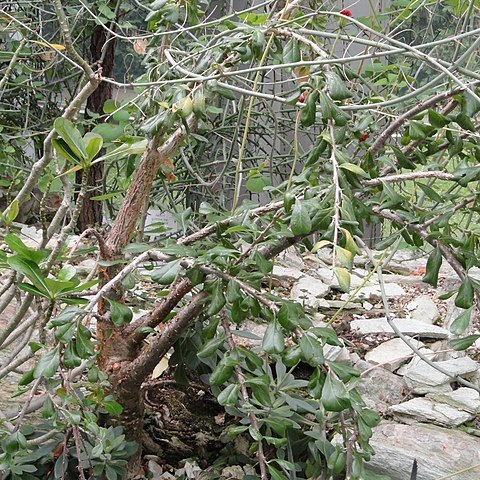Soft-stemmed shrub up to 4 m. tall, trunk swollen at the base, up to 1 m. in diam., from which arise several thick, erect main branches which taper rapidly; bark grey or mottled with yellow; branches stiff, sparingly branched, spiny; spines spreading to recurved, 5–10 mm., leaves deciduous, oblong to obovate, 1–2.5 cm. long, 4–6 mm. broad, obtuse to retuse at the apex, cuneate at the base, grey, semi-coriaceous, densely covered with stellately-branched mucilage glands; midrib distinct below, impressed above.
Corolla sparingly tomentose, with a long, cylindrical, only slightly curved tube, 8–10 cm. long, 4–6 mm. in diam., produced near the base into a short blunt spur, 1–1.5 cm. long, cream-coloured, sometimes suffused with purple; limb spreading at first, later reflexed, 4–5 cm. in diam., slightly oblique; lobes 5, subcircular, 1.6–2 cm. broad.
Ovary, oblong, 7–8 mm. long, laterally compressed, bilocular, each loculus divided by an incomplete false septum; ovules many, uniseriate in each compartment. Style slender, equaling the corolla tube; stigma reaching the corolla mouth or exerted by up to 10 mm., broadly bilobed.
Shrub, up to 4 m high. Branches spiny, spines 5-10 mm long, spreading to recurved. Leaves oblong to obovate, grey, densely covered with stellately branched mucilage glands. Flowers cream, sometimes suffused with purple.
Fruit a rigid woody capsule, obovate in outline, often retuse at the apex, 4–6 cm. long, 3.5–5 cm. broad, laterally compressed, greyish brown.
Flowers large, sweet-scented, 1–3 in short raceme-like inflorescences on short shoots which are sometimes elongated; pedicels 4 mm. long.
Seeds flat, transversely oblong, winged, about 1.5 cm. long and 2.5 cm. broad (incl. wings).
Stamens 4, subequal, inserted near the throat of the corolla tube; filaments 4–5 mm. long.
Calyx 5-partite, 4 mm. long.


